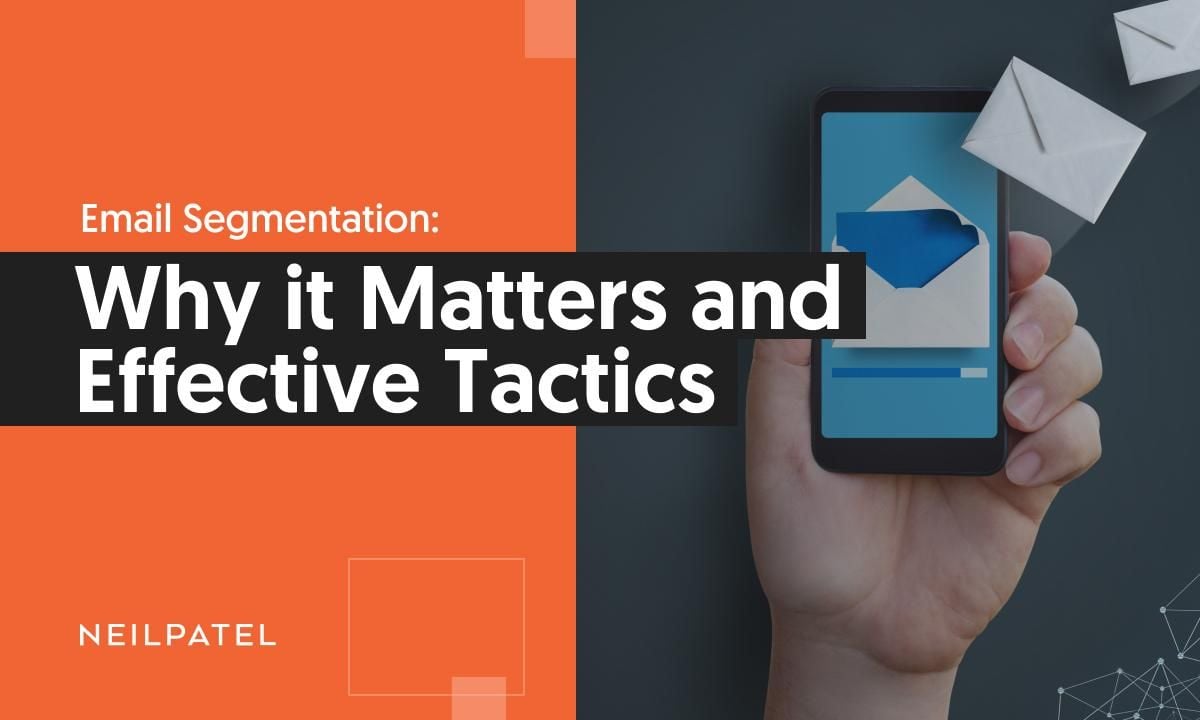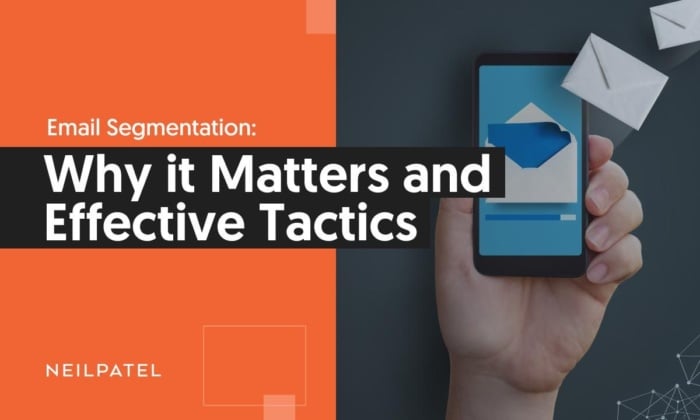Segmentation is crucial in email marketing. It enhances relevance and engagement.
But why does segmentation matter? Email marketing is a powerful tool. It reaches a wide audience quickly. But sending the same message to everyone can be ineffective. That’s where segmentation comes in. Segmentation means dividing your email list into smaller groups based on specific criteria.
These criteria can include demographics, behavior, or preferences. By doing this, you can tailor your messages to fit each group better. This increases the chances of your emails being opened and read. It also helps build stronger relationships with your audience. Segmentation makes your email marketing efforts more efficient and effective. It ensures that your messages resonate with your audience. So, understanding segmentation is key to successful email marketing.
Introduction To Segmentation
Email marketing is a powerful tool. It helps businesses connect with their audience. But what makes email marketing truly effective? The answer is segmentation. By dividing your audience into smaller groups, you can send more relevant messages. Let’s explore what segmentation is and why it matters in email marketing.
What Is Segmentation?
Segmentation is the process of dividing your email list into smaller groups. These groups share common characteristics. These characteristics can include:
- Demographics (age, gender, location)
- Behavior (past purchases, website activity)
- Preferences (interests, email engagement)
By segmenting your audience, you can tailor your messages to meet their needs. This leads to better engagement and higher conversion rates.
Importance In Email Marketing
Why is segmentation important in email marketing? Here are a few key reasons:
- Relevance: Segmented emails are more relevant to the recipient. This increases the chances of the email being opened and read.
- Personalization: You can personalize emails based on the recipient’s interests and behavior. This makes the recipient feel valued.
- Engagement: Relevant and personalized emails lead to higher engagement rates. This includes higher open rates, click-through rates, and conversions.
- Reduced Spam Complaints: When emails are relevant, recipients are less likely to mark them as spam. This improves your sender reputation.
In summary, segmentation is a vital part of email marketing. It helps you send the right message to the right person at the right time.
Benefits Of Segmentation
Segmentation is a powerful tool in email marketing. It helps target the right audience with the right message. By segmenting your email lists, you can create more personalized experiences. This leads to better engagement and customer loyalty. Here are some key benefits of segmentation:
Higher Engagement Rates
Sending personalized emails improves engagement rates. Segmented emails have higher open and click-through rates. People are more likely to read content that is relevant to them. This means more interaction and potential conversions.
Consider this example:
| Segment | Open Rate | Click-Through Rate |
|---|---|---|
| Non-segmented | 20% | 2% |
| Segmented | 40% | 5% |
As shown, segmented emails perform much better.
Improved Customer Retention
Segmentation helps in understanding customer needs. This leads to more relevant content. Happy customers are more likely to stay loyal. They feel valued and understood. Customer retention is critical for long-term success.
Benefits include:
- Increased customer loyalty
- Higher lifetime value
- Better customer satisfaction
By segmenting your audience, you can send tailored messages. This keeps your customers engaged and loyal. It’s a simple yet effective strategy.
Types Of Segmentation
Understanding the different types of segmentation in email marketing can boost your campaigns. Segmentation helps you send the right message to the right audience. It personalizes the experience for your subscribers. This increases engagement and conversion rates.
Demographic Segmentation
Demographic segmentation sorts your audience by age, gender, income, and education. This data helps tailor emails to specific groups. For example, young adults may prefer trendy products, while older audiences might look for practical items.
Behavioral Segmentation
Behavioral segmentation focuses on actions taken by subscribers. It includes data like purchase history, email opens, and website visits. This type of segmentation helps in sending targeted offers. For instance, if a user often clicks on tech articles, they might like tech product recommendations.

Credit: myemma.com
Creating Segmented Lists
Creating segmented lists in email marketing is essential for reaching the right audience. It helps deliver personalized content, leading to higher engagement and conversion rates. This section covers how to create these lists effectively.
Collecting Data
To create segmented lists, start with data collection. Gather information about your subscribers. You can do this through:
- Sign-up forms: Ask for basic details like name, age, and preferences.
- Surveys: Send short surveys to understand interests and needs.
- Website behavior: Track pages visited and products viewed.
- Purchase history: Note what subscribers have bought in the past.
Organize this data in a way that makes it easy to segment. Use categories such as:
| Category | Examples |
|---|---|
| Demographics | Age, Gender, Location |
| Behavior | Website activity, Purchase history |
| Preferences | Product interests, Content type |
Using Email Marketing Tools
Email marketing tools can help you create and manage segmented lists. These tools offer features like:
- Automated segmentation: Automatically group subscribers based on set criteria.
- Custom tags: Add tags to subscribers for easy filtering.
- Analytics: Track performance and adjust segments as needed.
Popular tools include:
- Mailchimp
- Constant Contact
- HubSpot
These tools simplify the process. They ensure your emails reach the right people with the right message. Use them to your advantage.
Personalization Techniques
Personalization techniques in email marketing help create a unique experience for each subscriber. By using these techniques, businesses can send more relevant and engaging emails. This approach not only improves open rates but also boosts customer loyalty.
Tailored Content
Tailored content is about sending the right message to the right person. Segment your audience based on their interests and behaviors. This allows you to deliver specific content that resonates with each group.
- Segment by purchase history
- Segment by browsing behavior
- Segment by demographic information
For example, if a subscriber often buys sports gear, send them updates about new sports products. If another subscriber frequently browses for kitchen appliances, showcase the latest kitchen gadgets. Tailored content helps increase engagement and conversions.
Dynamic Email Elements
Dynamic email elements change based on the recipient’s data. This makes each email feel personal and relevant. Use dynamic content to insert personalized greetings, product recommendations, and more.
| Element | Example |
|---|---|
| Personalized Greetings | Hello, [First Name] |
| Product Recommendations | Based on your recent purchase, you might like… |
| Location-Specific Offers | Special deal in [City] |
Dynamic elements make emails more engaging. They show that you understand each subscriber’s needs and preferences. This approach can lead to higher open and click-through rates.

Credit: neilpatel.com
Case Studies
Segmentation in email marketing is crucial. It allows businesses to target specific groups of customers with tailored content. This approach not only improves engagement but also boosts conversion rates. To illustrate its impact, let’s explore some case studies.
Successful Campaigns
Several companies have seen impressive results through email segmentation. Consider the following examples:
| Company | Strategy | Results |
|---|---|---|
| Company A | Segmented by purchase history | Increased sales by 20% |
| Company B | Segmented by user behavior | Boosted open rates by 15% |
| Company C | Segmented by demographics | Improved click-through rates by 25% |
Lessons Learned
These campaigns provide valuable insights:
- Know your audience: Understanding customer preferences is key. Segmenting based on purchase history or behavior helps send relevant content.
- Test different segments: Different groups may respond better to various types of emails. Experiment with demographics, interests, and behaviors.
- Personalize your content: Personalized emails are more engaging. Use customer names and tailor content to their interests.
- Analyze results: Track the performance of segmented campaigns. Use the data to refine your strategies and improve future campaigns.
Challenges In Segmentation
Segmentation is vital in email marketing to ensure messages reach the right audience. However, there are several challenges involved. Effective segmentation requires accurate data and respect for privacy laws. Below, we discuss two key challenges: data privacy concerns and maintaining data accuracy.
Data Privacy Concerns
Data privacy is a significant issue in email marketing. Many people worry about how their data is used. Marketers must comply with regulations like GDPR or CCPA. Failure to comply can result in hefty fines.
To protect data privacy, marketers should:
- Collect only necessary information
- Use secure data storage
- Provide clear privacy policies
Respecting user privacy builds trust. Trust leads to better engagement and higher conversion rates.
Maintaining Data Accuracy
Accurate data is essential for effective segmentation. Incorrect data can lead to sending irrelevant messages. This decreases open rates and increases unsubscribe rates.
To ensure data accuracy, marketers should:
- Regularly update their databases
- Validate email addresses at the point of collection
- Use tools to clean and manage data
Maintaining data accuracy requires ongoing effort. It is a continuous process, not a one-time task.
Inaccurate data can harm your brand’s reputation. Users appreciate relevant and timely messages.

Credit: neilpatel.com
Future Of Segmentation
The future of segmentation in email marketing looks bright. Technology is advancing rapidly. This evolution offers exciting opportunities for marketers. Let’s delve into two key areas shaping this future.
Ai And Machine Learning
AI and machine learning are transforming segmentation. These tools analyze huge amounts of data. They identify patterns and trends. This helps create highly personalized email campaigns. AI can predict customer behavior. This means better targeting and more effective emails.
Evolving Customer Expectations
Customers expect personalized experiences. They want relevant content. Generic emails no longer engage them. Segmentation meets these demands. It helps tailor messages to individual preferences. This leads to higher engagement and satisfaction. Meeting these expectations is crucial for success.
Frequently Asked Questions
What Is Segmentation In Email Marketing?
Segmentation in email marketing is dividing your email list into smaller, targeted groups. This allows you to send personalized, relevant content to each group.
Why Is Segmentation Important In Email Marketing?
Segmentation increases engagement and open rates by sending relevant content. It reduces unsubscribes and boosts conversions, making your email campaigns more effective.
How Does Segmentation Improve Email Performance?
Segmentation improves email performance by targeting specific audience needs and preferences. It ensures your emails are relevant, increasing open and click-through rates.
What Are The Benefits Of Email Segmentation?
Email segmentation leads to higher engagement, better customer retention, and increased conversions. It helps build stronger relationships with your audience by delivering personalized content.
Conclusion
Segmenting your email list boosts engagement and conversions. It allows for personalized content. This results in more satisfied subscribers. Happy subscribers are more likely to act. Segmentation also reduces unsubscribes and spam reports. This keeps your email list clean and healthy.
Targeted emails show you understand your audience. This builds trust and loyalty. Start segmenting now to see better results. Your email marketing can truly benefit.


Leave a Reply